Sexual Harassment in Workplace: Employer Liability and Legal Analysis
VerifiedAdded on 2021/04/21
|13
|3065
|329
Essay
AI Summary
This essay examines the issue of sexual harassment in the workplace, specifically focusing on employer liability in Canada. It begins with an introduction and thesis statement arguing for employer accountability. The essay then summarizes the relevant legal framework, including the Canada Labour Code and the Canadian Human Rights Act, and defines sexual harassment, including quid pro quo and hostile work environment types. It discusses the different types of harassment, the rights of employees, and the employer's responsibilities in preventing harassment, including policy requirements. The essay also explores the concept of workplace connection, comparing and contrasting different views on employer liability, including vicarious and organic liability, and the importance of a harassment-free environment. The essay also addresses reprisal, differentiating between general and sexual reprisal, and the importance of intent in such cases.
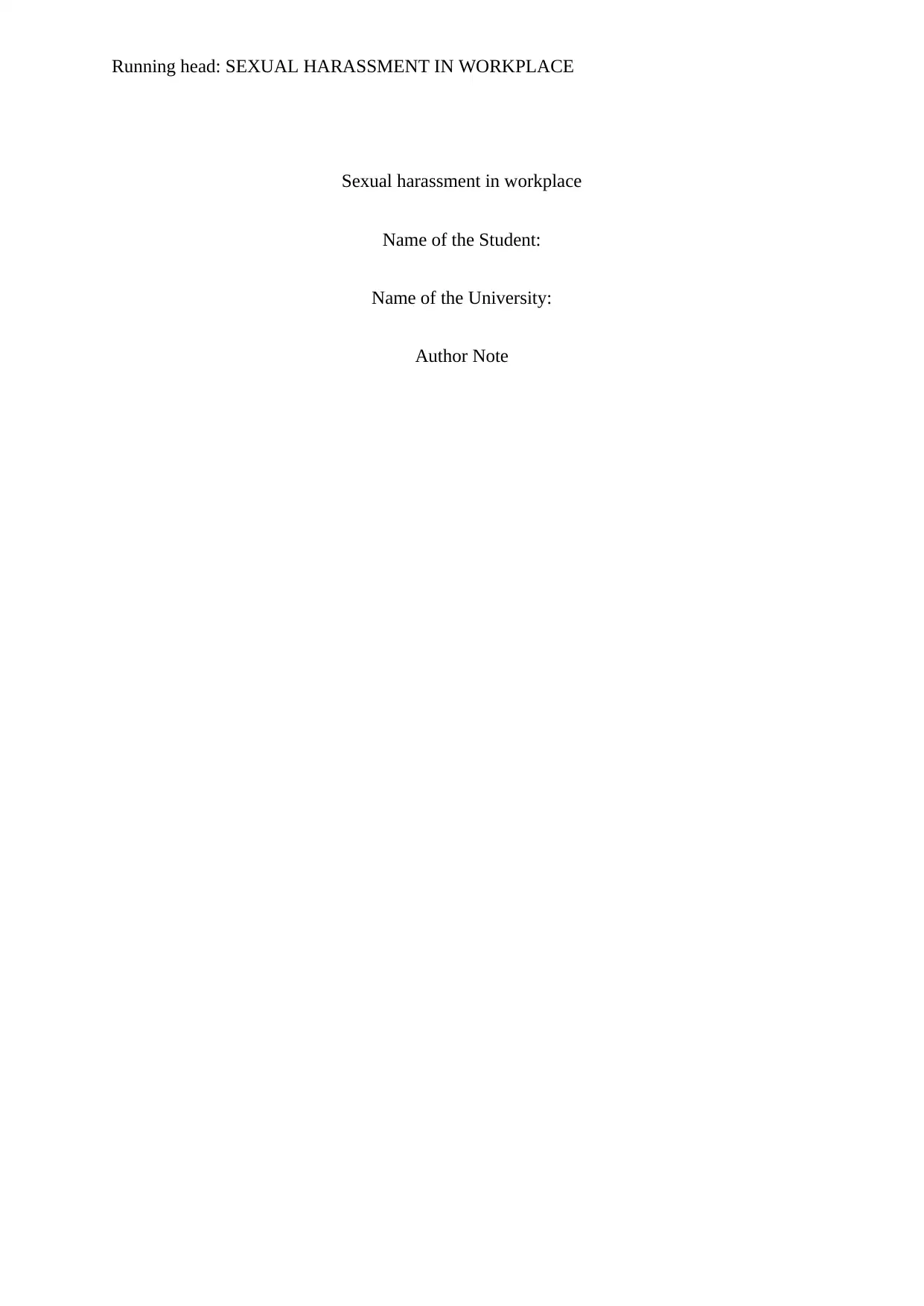
Running head: SEXUAL HARASSMENT IN WORKPLACE
Sexual harassment in workplace
Name of the Student:
Name of the University:
Author Note
Sexual harassment in workplace
Name of the Student:
Name of the University:
Author Note
Paraphrase This Document
Need a fresh take? Get an instant paraphrase of this document with our AI Paraphraser
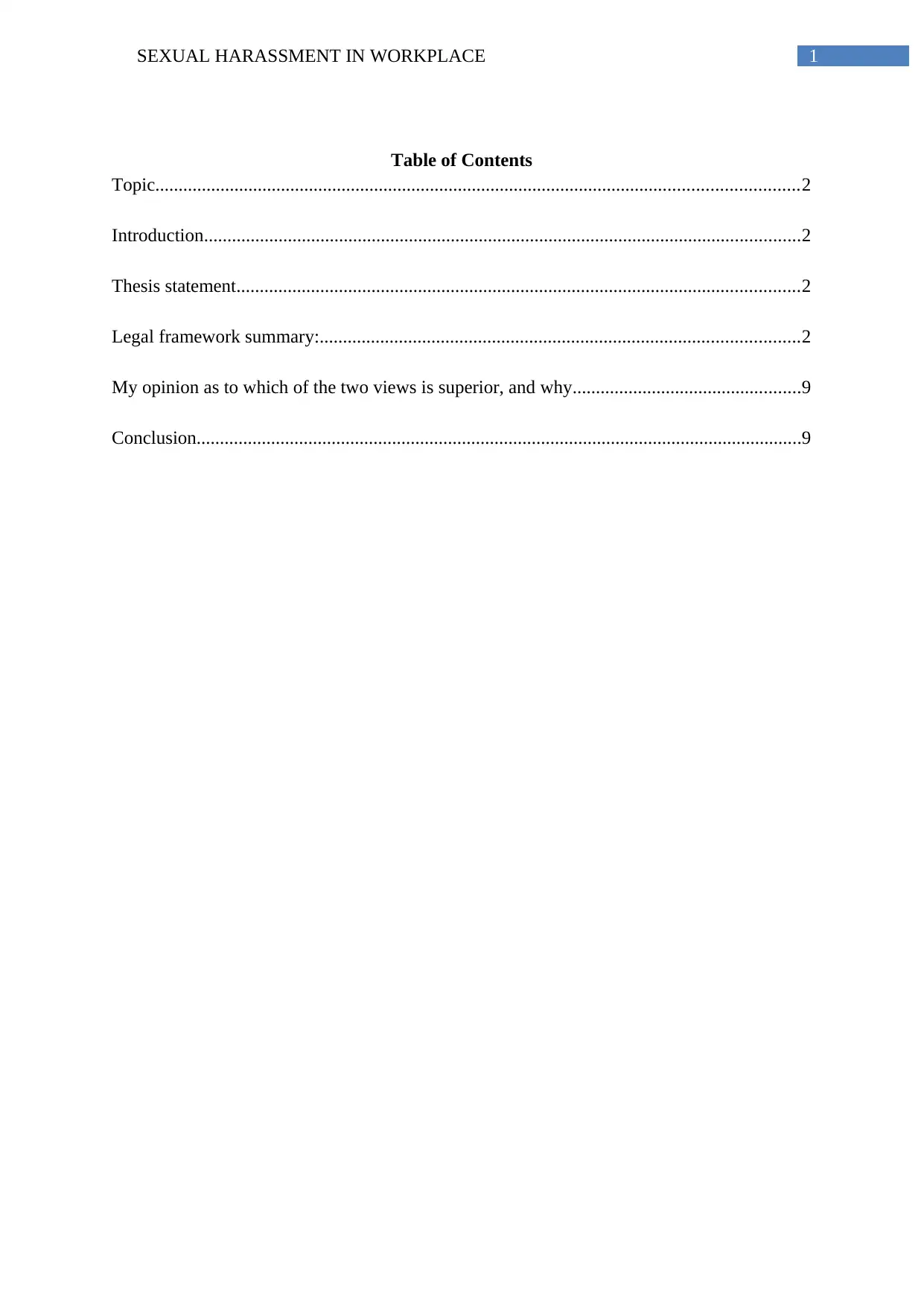
1SEXUAL HARASSMENT IN WORKPLACE
Table of Contents
Topic..........................................................................................................................................2
Introduction................................................................................................................................2
Thesis statement.........................................................................................................................2
Legal framework summary:.......................................................................................................2
My opinion as to which of the two views is superior, and why.................................................9
Conclusion..................................................................................................................................9
Table of Contents
Topic..........................................................................................................................................2
Introduction................................................................................................................................2
Thesis statement.........................................................................................................................2
Legal framework summary:.......................................................................................................2
My opinion as to which of the two views is superior, and why.................................................9
Conclusion..................................................................................................................................9
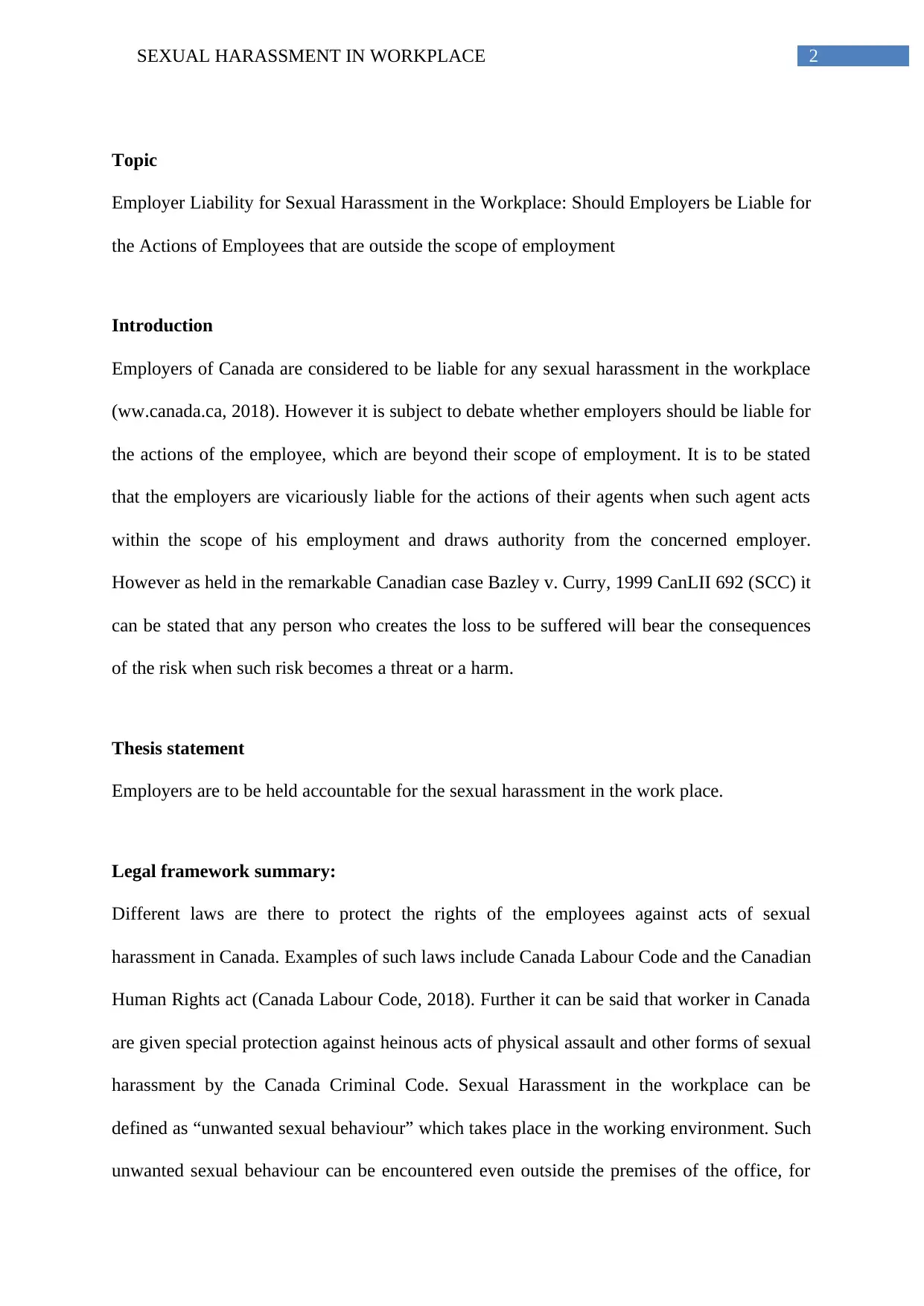
2SEXUAL HARASSMENT IN WORKPLACE
Topic
Employer Liability for Sexual Harassment in the Workplace: Should Employers be Liable for
the Actions of Employees that are outside the scope of employment
Introduction
Employers of Canada are considered to be liable for any sexual harassment in the workplace
(ww.canada.ca, 2018). However it is subject to debate whether employers should be liable for
the actions of the employee, which are beyond their scope of employment. It is to be stated
that the employers are vicariously liable for the actions of their agents when such agent acts
within the scope of his employment and draws authority from the concerned employer.
However as held in the remarkable Canadian case Bazley v. Curry, 1999 CanLII 692 (SCC) it
can be stated that any person who creates the loss to be suffered will bear the consequences
of the risk when such risk becomes a threat or a harm.
Thesis statement
Employers are to be held accountable for the sexual harassment in the work place.
Legal framework summary:
Different laws are there to protect the rights of the employees against acts of sexual
harassment in Canada. Examples of such laws include Canada Labour Code and the Canadian
Human Rights act (Canada Labour Code, 2018). Further it can be said that worker in Canada
are given special protection against heinous acts of physical assault and other forms of sexual
harassment by the Canada Criminal Code. Sexual Harassment in the workplace can be
defined as “unwanted sexual behaviour” which takes place in the working environment. Such
unwanted sexual behaviour can be encountered even outside the premises of the office, for
Topic
Employer Liability for Sexual Harassment in the Workplace: Should Employers be Liable for
the Actions of Employees that are outside the scope of employment
Introduction
Employers of Canada are considered to be liable for any sexual harassment in the workplace
(ww.canada.ca, 2018). However it is subject to debate whether employers should be liable for
the actions of the employee, which are beyond their scope of employment. It is to be stated
that the employers are vicariously liable for the actions of their agents when such agent acts
within the scope of his employment and draws authority from the concerned employer.
However as held in the remarkable Canadian case Bazley v. Curry, 1999 CanLII 692 (SCC) it
can be stated that any person who creates the loss to be suffered will bear the consequences
of the risk when such risk becomes a threat or a harm.
Thesis statement
Employers are to be held accountable for the sexual harassment in the work place.
Legal framework summary:
Different laws are there to protect the rights of the employees against acts of sexual
harassment in Canada. Examples of such laws include Canada Labour Code and the Canadian
Human Rights act (Canada Labour Code, 2018). Further it can be said that worker in Canada
are given special protection against heinous acts of physical assault and other forms of sexual
harassment by the Canada Criminal Code. Sexual Harassment in the workplace can be
defined as “unwanted sexual behaviour” which takes place in the working environment. Such
unwanted sexual behaviour can be encountered even outside the premises of the office, for
⊘ This is a preview!⊘
Do you want full access?
Subscribe today to unlock all pages.

Trusted by 1+ million students worldwide

3SEXUAL HARASSMENT IN WORKPLACE
example in office parties, conferences related to work or at any business deal. Sexual
behaviour can include sexual jokes, comments and sexual touching which are derogative and
demeaning to the victim employee. In the notable Canadian case Janzen v. Platy Enterprises
Ltd., 1989 1 SCR 1252 it was held by the supreme court that sexual harassment would be
constituted by any conduct which of sexual nature and which affects the work environment
and the other co-workers or constitutes adverse job related to consequences for the victims of
such harassment( www.globeandmail.com, 2018). In the aforementioned case it was also held
by the Supreme Court that Sexual Harassment can even include sexual discrimination. Sexual
discrimination has an adverse effect on the opportunities and condition of employment,
which are provided to the employees on the basis of their gender related characteristics. It
was held in the case Janzen v. Platy Enterprises Ltd., 1989 1 SCR 1252 that employers are
also liable for the wrongful actions of the offending employee.
It is to be stated that there are two types of sexual harassments that generally occur at
workplaces. They are:
Quid pro quo
Hostile work environment
Quid pro quo sexual harassment
The term Quid Pro is a Latin term which means “this for that”. It can also translate to a
“favour for a favour’. An example of Quid pro quo is when a supervisor or superior at work
tends to favour an employee if such employee submits to the sexual advances of the senior
(Becton, Gilstrap & Forsyth, 2017). It is to be mentioned that this constitutes abuse and
misuse of authority and it is illegal irrespective of the fact whether the employee submits to
the sexual advances of the superior at work.
example in office parties, conferences related to work or at any business deal. Sexual
behaviour can include sexual jokes, comments and sexual touching which are derogative and
demeaning to the victim employee. In the notable Canadian case Janzen v. Platy Enterprises
Ltd., 1989 1 SCR 1252 it was held by the supreme court that sexual harassment would be
constituted by any conduct which of sexual nature and which affects the work environment
and the other co-workers or constitutes adverse job related to consequences for the victims of
such harassment( www.globeandmail.com, 2018). In the aforementioned case it was also held
by the Supreme Court that Sexual Harassment can even include sexual discrimination. Sexual
discrimination has an adverse effect on the opportunities and condition of employment,
which are provided to the employees on the basis of their gender related characteristics. It
was held in the case Janzen v. Platy Enterprises Ltd., 1989 1 SCR 1252 that employers are
also liable for the wrongful actions of the offending employee.
It is to be stated that there are two types of sexual harassments that generally occur at
workplaces. They are:
Quid pro quo
Hostile work environment
Quid pro quo sexual harassment
The term Quid Pro is a Latin term which means “this for that”. It can also translate to a
“favour for a favour’. An example of Quid pro quo is when a supervisor or superior at work
tends to favour an employee if such employee submits to the sexual advances of the senior
(Becton, Gilstrap & Forsyth, 2017). It is to be mentioned that this constitutes abuse and
misuse of authority and it is illegal irrespective of the fact whether the employee submits to
the sexual advances of the superior at work.
Paraphrase This Document
Need a fresh take? Get an instant paraphrase of this document with our AI Paraphraser
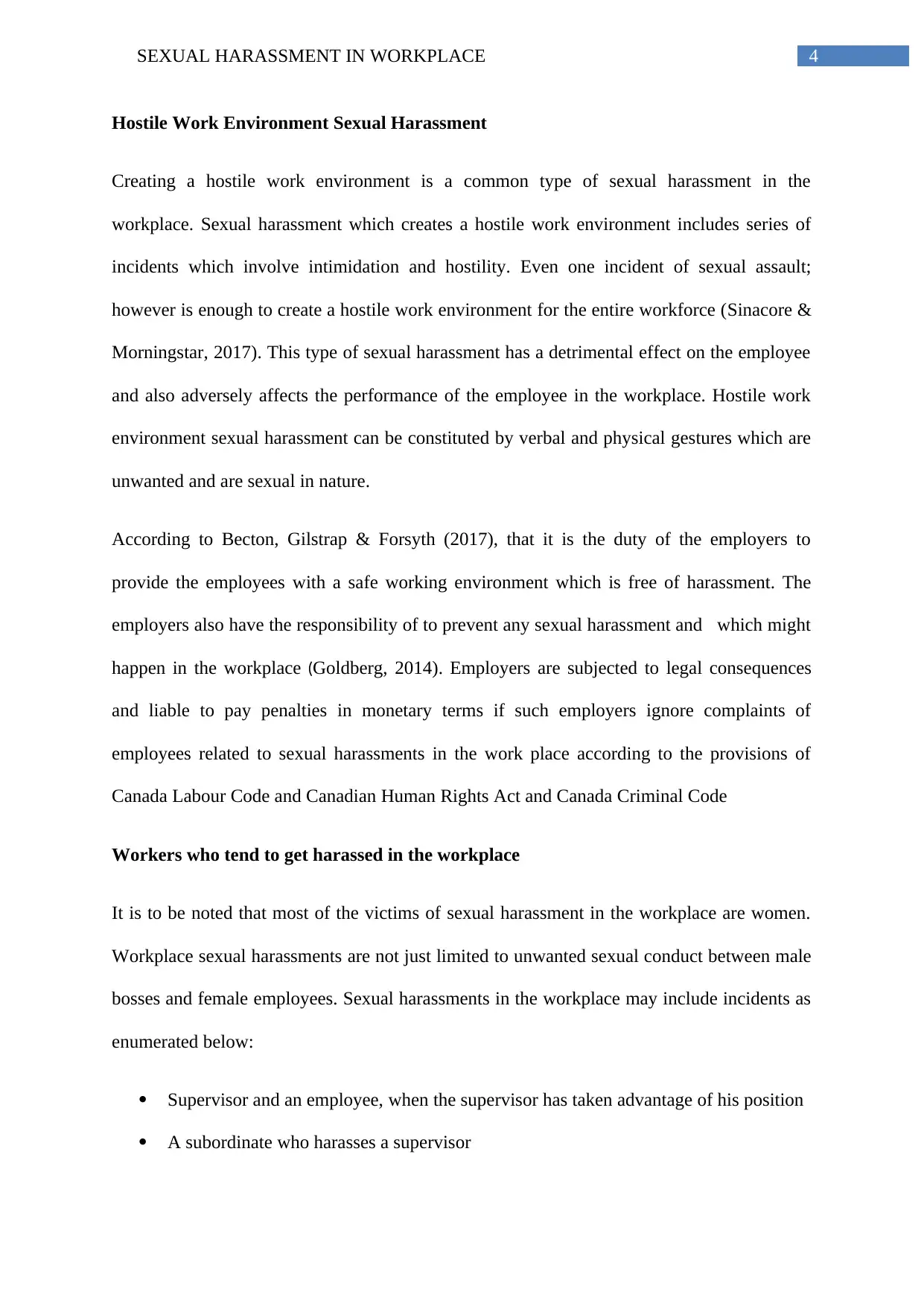
4SEXUAL HARASSMENT IN WORKPLACE
Hostile Work Environment Sexual Harassment
Creating a hostile work environment is a common type of sexual harassment in the
workplace. Sexual harassment which creates a hostile work environment includes series of
incidents which involve intimidation and hostility. Even one incident of sexual assault;
however is enough to create a hostile work environment for the entire workforce (Sinacore &
Morningstar, 2017). This type of sexual harassment has a detrimental effect on the employee
and also adversely affects the performance of the employee in the workplace. Hostile work
environment sexual harassment can be constituted by verbal and physical gestures which are
unwanted and are sexual in nature.
According to Becton, Gilstrap & Forsyth (2017), that it is the duty of the employers to
provide the employees with a safe working environment which is free of harassment. The
employers also have the responsibility of to prevent any sexual harassment and which might
happen in the workplace (Goldberg, 2014). Employers are subjected to legal consequences
and liable to pay penalties in monetary terms if such employers ignore complaints of
employees related to sexual harassments in the work place according to the provisions of
Canada Labour Code and Canadian Human Rights Act and Canada Criminal Code
Workers who tend to get harassed in the workplace
It is to be noted that most of the victims of sexual harassment in the workplace are women.
Workplace sexual harassments are not just limited to unwanted sexual conduct between male
bosses and female employees. Sexual harassments in the workplace may include incidents as
enumerated below:
Supervisor and an employee, when the supervisor has taken advantage of his position
A subordinate who harasses a supervisor
Hostile Work Environment Sexual Harassment
Creating a hostile work environment is a common type of sexual harassment in the
workplace. Sexual harassment which creates a hostile work environment includes series of
incidents which involve intimidation and hostility. Even one incident of sexual assault;
however is enough to create a hostile work environment for the entire workforce (Sinacore &
Morningstar, 2017). This type of sexual harassment has a detrimental effect on the employee
and also adversely affects the performance of the employee in the workplace. Hostile work
environment sexual harassment can be constituted by verbal and physical gestures which are
unwanted and are sexual in nature.
According to Becton, Gilstrap & Forsyth (2017), that it is the duty of the employers to
provide the employees with a safe working environment which is free of harassment. The
employers also have the responsibility of to prevent any sexual harassment and which might
happen in the workplace (Goldberg, 2014). Employers are subjected to legal consequences
and liable to pay penalties in monetary terms if such employers ignore complaints of
employees related to sexual harassments in the work place according to the provisions of
Canada Labour Code and Canadian Human Rights Act and Canada Criminal Code
Workers who tend to get harassed in the workplace
It is to be noted that most of the victims of sexual harassment in the workplace are women.
Workplace sexual harassments are not just limited to unwanted sexual conduct between male
bosses and female employees. Sexual harassments in the workplace may include incidents as
enumerated below:
Supervisor and an employee, when the supervisor has taken advantage of his position
A subordinate who harasses a supervisor
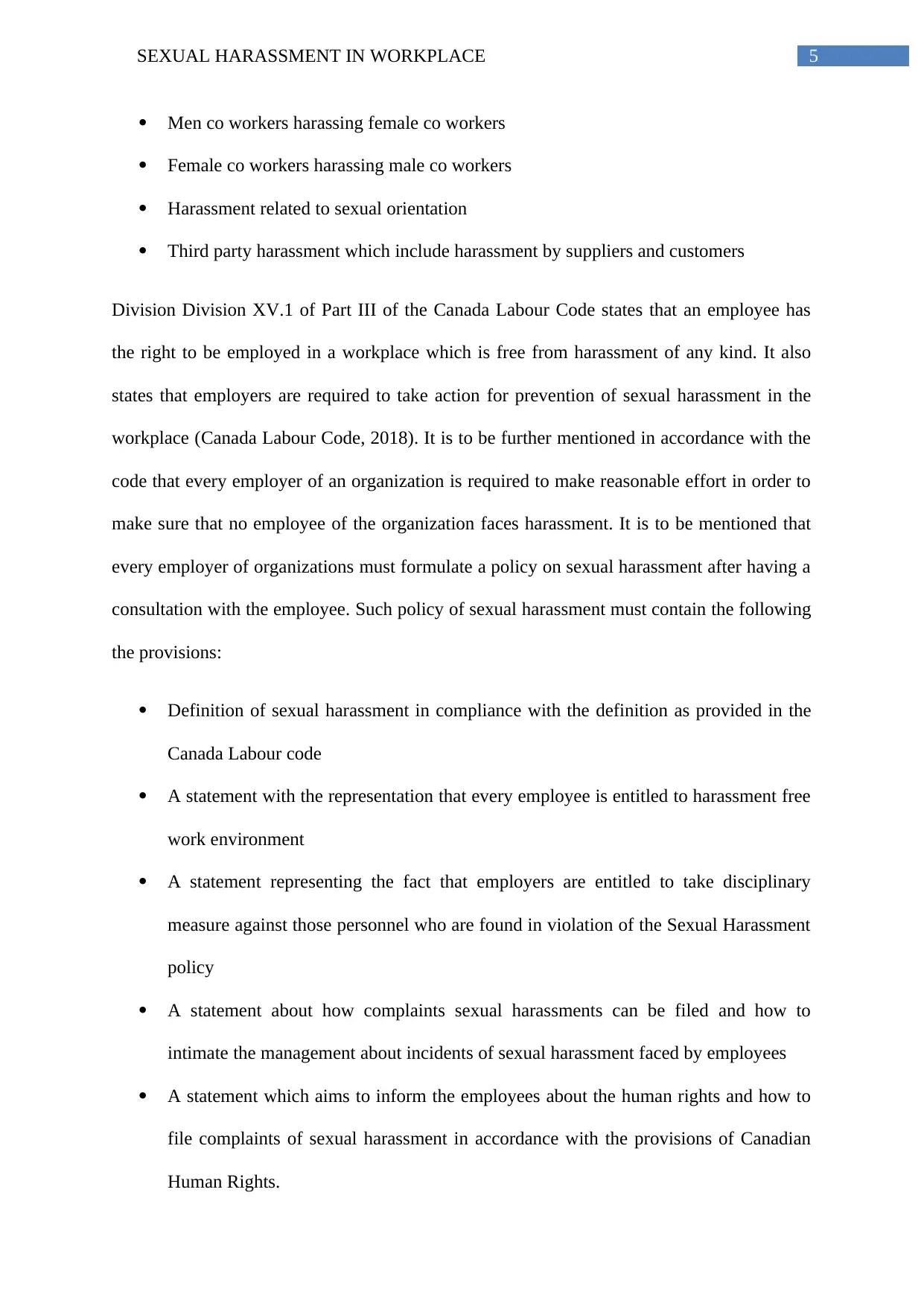
5SEXUAL HARASSMENT IN WORKPLACE
Men co workers harassing female co workers
Female co workers harassing male co workers
Harassment related to sexual orientation
Third party harassment which include harassment by suppliers and customers
Division Division XV.1 of Part III of the Canada Labour Code states that an employee has
the right to be employed in a workplace which is free from harassment of any kind. It also
states that employers are required to take action for prevention of sexual harassment in the
workplace (Canada Labour Code, 2018). It is to be further mentioned in accordance with the
code that every employer of an organization is required to make reasonable effort in order to
make sure that no employee of the organization faces harassment. It is to be mentioned that
every employer of organizations must formulate a policy on sexual harassment after having a
consultation with the employee. Such policy of sexual harassment must contain the following
the provisions:
Definition of sexual harassment in compliance with the definition as provided in the
Canada Labour code
A statement with the representation that every employee is entitled to harassment free
work environment
A statement representing the fact that employers are entitled to take disciplinary
measure against those personnel who are found in violation of the Sexual Harassment
policy
A statement about how complaints sexual harassments can be filed and how to
intimate the management about incidents of sexual harassment faced by employees
A statement which aims to inform the employees about the human rights and how to
file complaints of sexual harassment in accordance with the provisions of Canadian
Human Rights.
Men co workers harassing female co workers
Female co workers harassing male co workers
Harassment related to sexual orientation
Third party harassment which include harassment by suppliers and customers
Division Division XV.1 of Part III of the Canada Labour Code states that an employee has
the right to be employed in a workplace which is free from harassment of any kind. It also
states that employers are required to take action for prevention of sexual harassment in the
workplace (Canada Labour Code, 2018). It is to be further mentioned in accordance with the
code that every employer of an organization is required to make reasonable effort in order to
make sure that no employee of the organization faces harassment. It is to be mentioned that
every employer of organizations must formulate a policy on sexual harassment after having a
consultation with the employee. Such policy of sexual harassment must contain the following
the provisions:
Definition of sexual harassment in compliance with the definition as provided in the
Canada Labour code
A statement with the representation that every employee is entitled to harassment free
work environment
A statement representing the fact that employers are entitled to take disciplinary
measure against those personnel who are found in violation of the Sexual Harassment
policy
A statement about how complaints sexual harassments can be filed and how to
intimate the management about incidents of sexual harassment faced by employees
A statement which aims to inform the employees about the human rights and how to
file complaints of sexual harassment in accordance with the provisions of Canadian
Human Rights.
⊘ This is a preview!⊘
Do you want full access?
Subscribe today to unlock all pages.

Trusted by 1+ million students worldwide
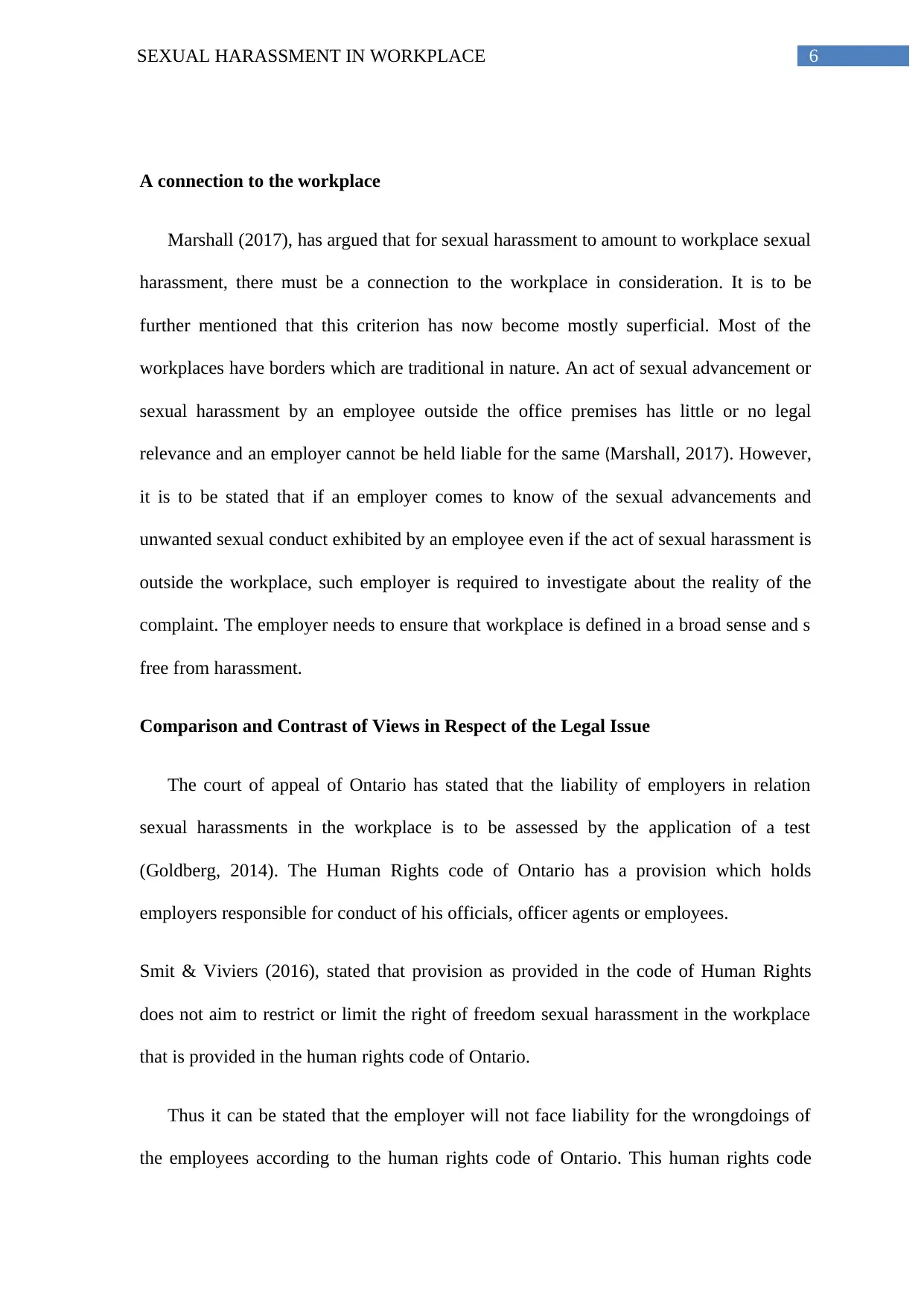
6SEXUAL HARASSMENT IN WORKPLACE
A connection to the workplace
Marshall (2017), has argued that for sexual harassment to amount to workplace sexual
harassment, there must be a connection to the workplace in consideration. It is to be
further mentioned that this criterion has now become mostly superficial. Most of the
workplaces have borders which are traditional in nature. An act of sexual advancement or
sexual harassment by an employee outside the office premises has little or no legal
relevance and an employer cannot be held liable for the same (Marshall, 2017). However,
it is to be stated that if an employer comes to know of the sexual advancements and
unwanted sexual conduct exhibited by an employee even if the act of sexual harassment is
outside the workplace, such employer is required to investigate about the reality of the
complaint. The employer needs to ensure that workplace is defined in a broad sense and s
free from harassment.
Comparison and Contrast of Views in Respect of the Legal Issue
The court of appeal of Ontario has stated that the liability of employers in relation
sexual harassments in the workplace is to be assessed by the application of a test
(Goldberg, 2014). The Human Rights code of Ontario has a provision which holds
employers responsible for conduct of his officials, officer agents or employees.
Smit & Viviers (2016), stated that provision as provided in the code of Human Rights
does not aim to restrict or limit the right of freedom sexual harassment in the workplace
that is provided in the human rights code of Ontario.
Thus it can be stated that the employer will not face liability for the wrongdoings of
the employees according to the human rights code of Ontario. This human rights code
A connection to the workplace
Marshall (2017), has argued that for sexual harassment to amount to workplace sexual
harassment, there must be a connection to the workplace in consideration. It is to be
further mentioned that this criterion has now become mostly superficial. Most of the
workplaces have borders which are traditional in nature. An act of sexual advancement or
sexual harassment by an employee outside the office premises has little or no legal
relevance and an employer cannot be held liable for the same (Marshall, 2017). However,
it is to be stated that if an employer comes to know of the sexual advancements and
unwanted sexual conduct exhibited by an employee even if the act of sexual harassment is
outside the workplace, such employer is required to investigate about the reality of the
complaint. The employer needs to ensure that workplace is defined in a broad sense and s
free from harassment.
Comparison and Contrast of Views in Respect of the Legal Issue
The court of appeal of Ontario has stated that the liability of employers in relation
sexual harassments in the workplace is to be assessed by the application of a test
(Goldberg, 2014). The Human Rights code of Ontario has a provision which holds
employers responsible for conduct of his officials, officer agents or employees.
Smit & Viviers (2016), stated that provision as provided in the code of Human Rights
does not aim to restrict or limit the right of freedom sexual harassment in the workplace
that is provided in the human rights code of Ontario.
Thus it can be stated that the employer will not face liability for the wrongdoings of
the employees according to the human rights code of Ontario. This human rights code
Paraphrase This Document
Need a fresh take? Get an instant paraphrase of this document with our AI Paraphraser
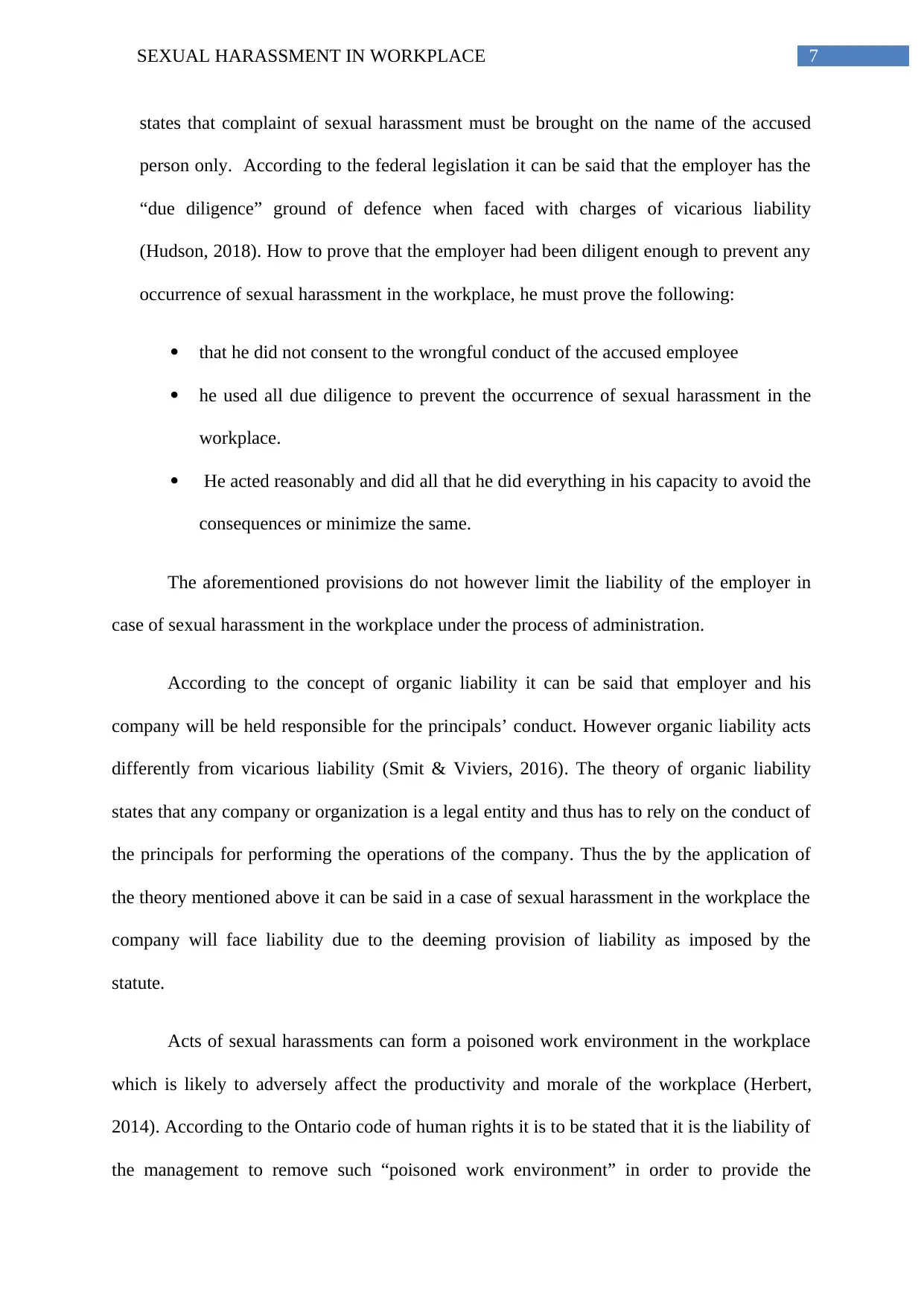
7SEXUAL HARASSMENT IN WORKPLACE
states that complaint of sexual harassment must be brought on the name of the accused
person only. According to the federal legislation it can be said that the employer has the
“due diligence” ground of defence when faced with charges of vicarious liability
(Hudson, 2018). How to prove that the employer had been diligent enough to prevent any
occurrence of sexual harassment in the workplace, he must prove the following:
that he did not consent to the wrongful conduct of the accused employee
he used all due diligence to prevent the occurrence of sexual harassment in the
workplace.
He acted reasonably and did all that he did everything in his capacity to avoid the
consequences or minimize the same.
The aforementioned provisions do not however limit the liability of the employer in
case of sexual harassment in the workplace under the process of administration.
According to the concept of organic liability it can be said that employer and his
company will be held responsible for the principals’ conduct. However organic liability acts
differently from vicarious liability (Smit & Viviers, 2016). The theory of organic liability
states that any company or organization is a legal entity and thus has to rely on the conduct of
the principals for performing the operations of the company. Thus the by the application of
the theory mentioned above it can be said in a case of sexual harassment in the workplace the
company will face liability due to the deeming provision of liability as imposed by the
statute.
Acts of sexual harassments can form a poisoned work environment in the workplace
which is likely to adversely affect the productivity and morale of the workplace (Herbert,
2014). According to the Ontario code of human rights it is to be stated that it is the liability of
the management to remove such “poisoned work environment” in order to provide the
states that complaint of sexual harassment must be brought on the name of the accused
person only. According to the federal legislation it can be said that the employer has the
“due diligence” ground of defence when faced with charges of vicarious liability
(Hudson, 2018). How to prove that the employer had been diligent enough to prevent any
occurrence of sexual harassment in the workplace, he must prove the following:
that he did not consent to the wrongful conduct of the accused employee
he used all due diligence to prevent the occurrence of sexual harassment in the
workplace.
He acted reasonably and did all that he did everything in his capacity to avoid the
consequences or minimize the same.
The aforementioned provisions do not however limit the liability of the employer in
case of sexual harassment in the workplace under the process of administration.
According to the concept of organic liability it can be said that employer and his
company will be held responsible for the principals’ conduct. However organic liability acts
differently from vicarious liability (Smit & Viviers, 2016). The theory of organic liability
states that any company or organization is a legal entity and thus has to rely on the conduct of
the principals for performing the operations of the company. Thus the by the application of
the theory mentioned above it can be said in a case of sexual harassment in the workplace the
company will face liability due to the deeming provision of liability as imposed by the
statute.
Acts of sexual harassments can form a poisoned work environment in the workplace
which is likely to adversely affect the productivity and morale of the workplace (Herbert,
2014). According to the Ontario code of human rights it is to be stated that it is the liability of
the management to remove such “poisoned work environment” in order to provide the
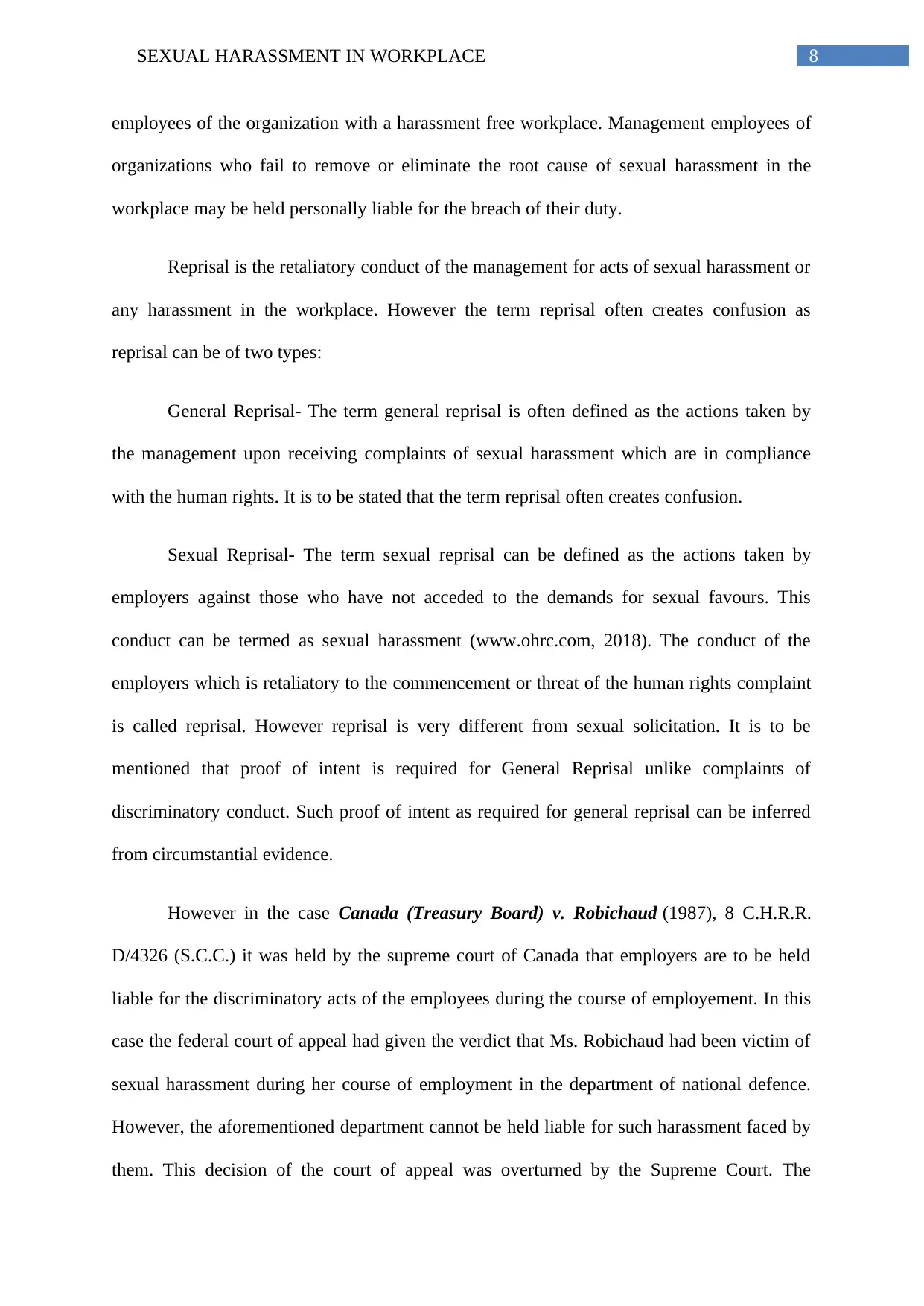
8SEXUAL HARASSMENT IN WORKPLACE
employees of the organization with a harassment free workplace. Management employees of
organizations who fail to remove or eliminate the root cause of sexual harassment in the
workplace may be held personally liable for the breach of their duty.
Reprisal is the retaliatory conduct of the management for acts of sexual harassment or
any harassment in the workplace. However the term reprisal often creates confusion as
reprisal can be of two types:
General Reprisal- The term general reprisal is often defined as the actions taken by
the management upon receiving complaints of sexual harassment which are in compliance
with the human rights. It is to be stated that the term reprisal often creates confusion.
Sexual Reprisal- The term sexual reprisal can be defined as the actions taken by
employers against those who have not acceded to the demands for sexual favours. This
conduct can be termed as sexual harassment (www.ohrc.com, 2018). The conduct of the
employers which is retaliatory to the commencement or threat of the human rights complaint
is called reprisal. However reprisal is very different from sexual solicitation. It is to be
mentioned that proof of intent is required for General Reprisal unlike complaints of
discriminatory conduct. Such proof of intent as required for general reprisal can be inferred
from circumstantial evidence.
However in the case Canada (Treasury Board) v. Robichaud (1987), 8 C.H.R.R.
D/4326 (S.C.C.) it was held by the supreme court of Canada that employers are to be held
liable for the discriminatory acts of the employees during the course of employement. In this
case the federal court of appeal had given the verdict that Ms. Robichaud had been victim of
sexual harassment during her course of employment in the department of national defence.
However, the aforementioned department cannot be held liable for such harassment faced by
them. This decision of the court of appeal was overturned by the Supreme Court. The
employees of the organization with a harassment free workplace. Management employees of
organizations who fail to remove or eliminate the root cause of sexual harassment in the
workplace may be held personally liable for the breach of their duty.
Reprisal is the retaliatory conduct of the management for acts of sexual harassment or
any harassment in the workplace. However the term reprisal often creates confusion as
reprisal can be of two types:
General Reprisal- The term general reprisal is often defined as the actions taken by
the management upon receiving complaints of sexual harassment which are in compliance
with the human rights. It is to be stated that the term reprisal often creates confusion.
Sexual Reprisal- The term sexual reprisal can be defined as the actions taken by
employers against those who have not acceded to the demands for sexual favours. This
conduct can be termed as sexual harassment (www.ohrc.com, 2018). The conduct of the
employers which is retaliatory to the commencement or threat of the human rights complaint
is called reprisal. However reprisal is very different from sexual solicitation. It is to be
mentioned that proof of intent is required for General Reprisal unlike complaints of
discriminatory conduct. Such proof of intent as required for general reprisal can be inferred
from circumstantial evidence.
However in the case Canada (Treasury Board) v. Robichaud (1987), 8 C.H.R.R.
D/4326 (S.C.C.) it was held by the supreme court of Canada that employers are to be held
liable for the discriminatory acts of the employees during the course of employement. In this
case the federal court of appeal had given the verdict that Ms. Robichaud had been victim of
sexual harassment during her course of employment in the department of national defence.
However, the aforementioned department cannot be held liable for such harassment faced by
them. This decision of the court of appeal was overturned by the Supreme Court. The
⊘ This is a preview!⊘
Do you want full access?
Subscribe today to unlock all pages.

Trusted by 1+ million students worldwide
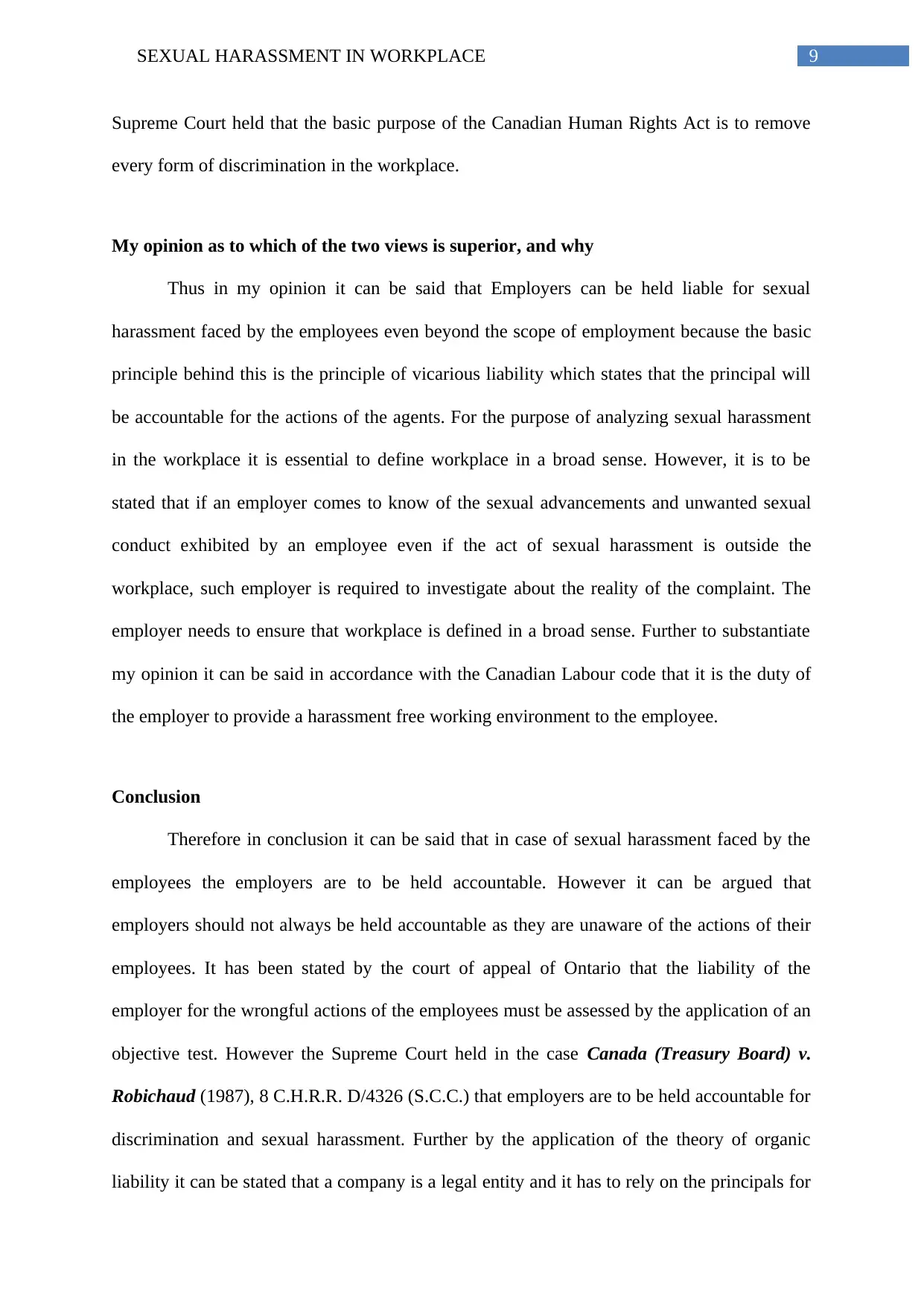
9SEXUAL HARASSMENT IN WORKPLACE
Supreme Court held that the basic purpose of the Canadian Human Rights Act is to remove
every form of discrimination in the workplace.
My opinion as to which of the two views is superior, and why
Thus in my opinion it can be said that Employers can be held liable for sexual
harassment faced by the employees even beyond the scope of employment because the basic
principle behind this is the principle of vicarious liability which states that the principal will
be accountable for the actions of the agents. For the purpose of analyzing sexual harassment
in the workplace it is essential to define workplace in a broad sense. However, it is to be
stated that if an employer comes to know of the sexual advancements and unwanted sexual
conduct exhibited by an employee even if the act of sexual harassment is outside the
workplace, such employer is required to investigate about the reality of the complaint. The
employer needs to ensure that workplace is defined in a broad sense. Further to substantiate
my opinion it can be said in accordance with the Canadian Labour code that it is the duty of
the employer to provide a harassment free working environment to the employee.
Conclusion
Therefore in conclusion it can be said that in case of sexual harassment faced by the
employees the employers are to be held accountable. However it can be argued that
employers should not always be held accountable as they are unaware of the actions of their
employees. It has been stated by the court of appeal of Ontario that the liability of the
employer for the wrongful actions of the employees must be assessed by the application of an
objective test. However the Supreme Court held in the case Canada (Treasury Board) v.
Robichaud (1987), 8 C.H.R.R. D/4326 (S.C.C.) that employers are to be held accountable for
discrimination and sexual harassment. Further by the application of the theory of organic
liability it can be stated that a company is a legal entity and it has to rely on the principals for
Supreme Court held that the basic purpose of the Canadian Human Rights Act is to remove
every form of discrimination in the workplace.
My opinion as to which of the two views is superior, and why
Thus in my opinion it can be said that Employers can be held liable for sexual
harassment faced by the employees even beyond the scope of employment because the basic
principle behind this is the principle of vicarious liability which states that the principal will
be accountable for the actions of the agents. For the purpose of analyzing sexual harassment
in the workplace it is essential to define workplace in a broad sense. However, it is to be
stated that if an employer comes to know of the sexual advancements and unwanted sexual
conduct exhibited by an employee even if the act of sexual harassment is outside the
workplace, such employer is required to investigate about the reality of the complaint. The
employer needs to ensure that workplace is defined in a broad sense. Further to substantiate
my opinion it can be said in accordance with the Canadian Labour code that it is the duty of
the employer to provide a harassment free working environment to the employee.
Conclusion
Therefore in conclusion it can be said that in case of sexual harassment faced by the
employees the employers are to be held accountable. However it can be argued that
employers should not always be held accountable as they are unaware of the actions of their
employees. It has been stated by the court of appeal of Ontario that the liability of the
employer for the wrongful actions of the employees must be assessed by the application of an
objective test. However the Supreme Court held in the case Canada (Treasury Board) v.
Robichaud (1987), 8 C.H.R.R. D/4326 (S.C.C.) that employers are to be held accountable for
discrimination and sexual harassment. Further by the application of the theory of organic
liability it can be stated that a company is a legal entity and it has to rely on the principals for
Paraphrase This Document
Need a fresh take? Get an instant paraphrase of this document with our AI Paraphraser
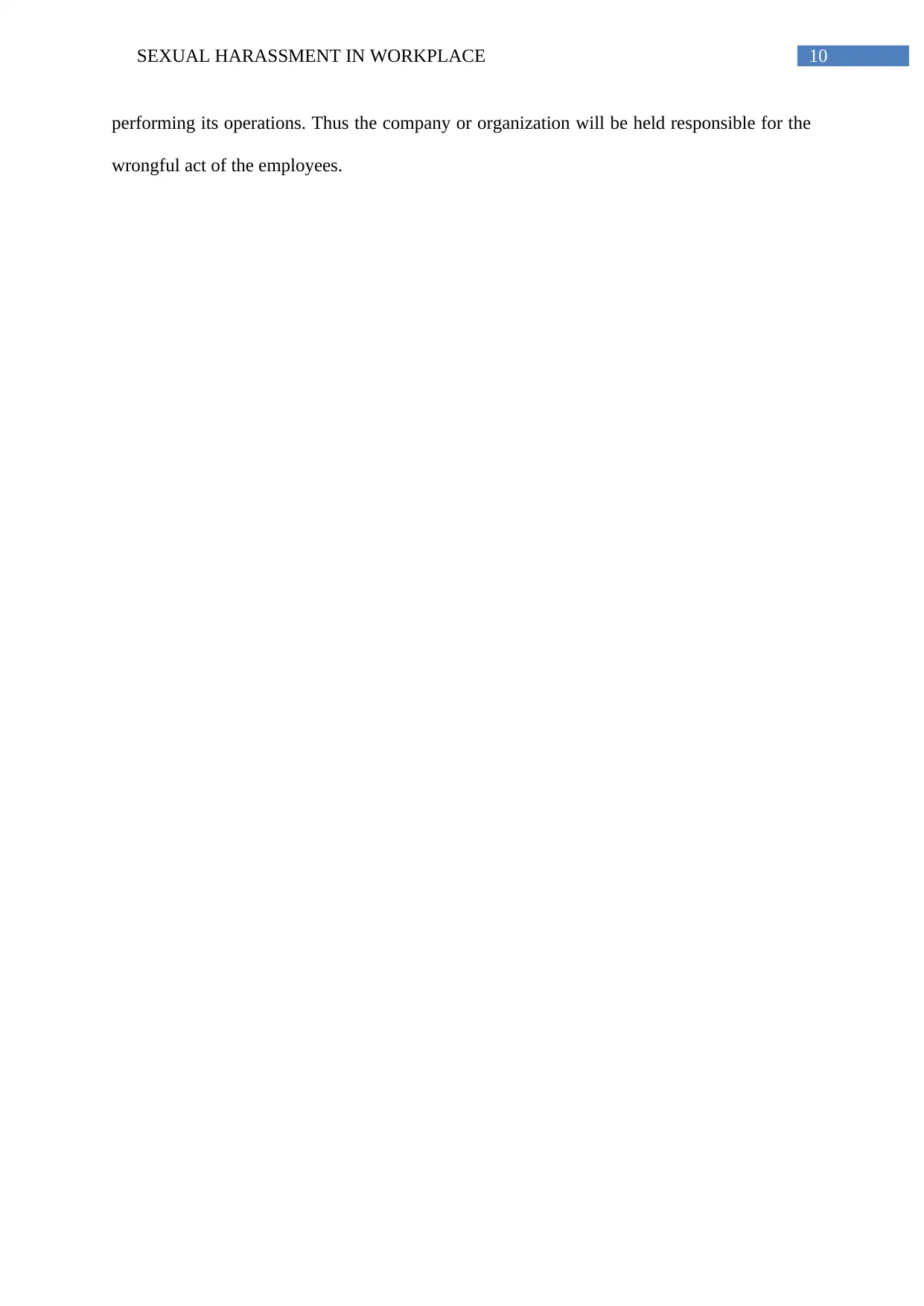
10SEXUAL HARASSMENT IN WORKPLACE
performing its operations. Thus the company or organization will be held responsible for the
wrongful act of the employees.
performing its operations. Thus the company or organization will be held responsible for the
wrongful act of the employees.
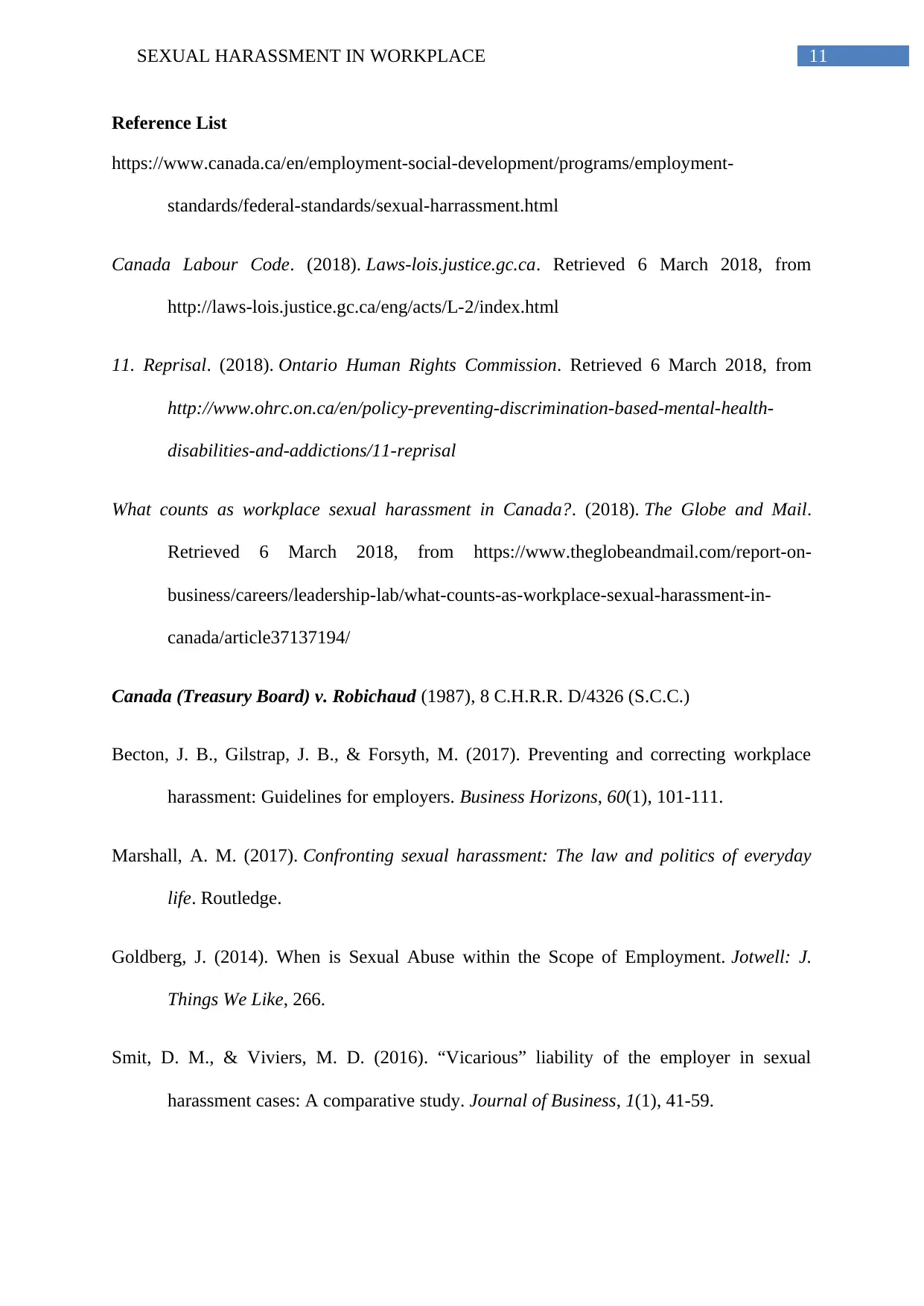
11SEXUAL HARASSMENT IN WORKPLACE
Reference List
https://www.canada.ca/en/employment-social-development/programs/employment-
standards/federal-standards/sexual-harrassment.html
Canada Labour Code. (2018). Laws-lois.justice.gc.ca. Retrieved 6 March 2018, from
http://laws-lois.justice.gc.ca/eng/acts/L-2/index.html
11. Reprisal. (2018). Ontario Human Rights Commission. Retrieved 6 March 2018, from
http://www.ohrc.on.ca/en/policy-preventing-discrimination-based-mental-health-
disabilities-and-addictions/11-reprisal
What counts as workplace sexual harassment in Canada?. (2018). The Globe and Mail.
Retrieved 6 March 2018, from https://www.theglobeandmail.com/report-on-
business/careers/leadership-lab/what-counts-as-workplace-sexual-harassment-in-
canada/article37137194/
Canada (Treasury Board) v. Robichaud (1987), 8 C.H.R.R. D/4326 (S.C.C.)
Becton, J. B., Gilstrap, J. B., & Forsyth, M. (2017). Preventing and correcting workplace
harassment: Guidelines for employers. Business Horizons, 60(1), 101-111.
Marshall, A. M. (2017). Confronting sexual harassment: The law and politics of everyday
life. Routledge.
Goldberg, J. (2014). When is Sexual Abuse within the Scope of Employment. Jotwell: J.
Things We Like, 266.
Smit, D. M., & Viviers, M. D. (2016). “Vicarious” liability of the employer in sexual
harassment cases: A comparative study. Journal of Business, 1(1), 41-59.
Reference List
https://www.canada.ca/en/employment-social-development/programs/employment-
standards/federal-standards/sexual-harrassment.html
Canada Labour Code. (2018). Laws-lois.justice.gc.ca. Retrieved 6 March 2018, from
http://laws-lois.justice.gc.ca/eng/acts/L-2/index.html
11. Reprisal. (2018). Ontario Human Rights Commission. Retrieved 6 March 2018, from
http://www.ohrc.on.ca/en/policy-preventing-discrimination-based-mental-health-
disabilities-and-addictions/11-reprisal
What counts as workplace sexual harassment in Canada?. (2018). The Globe and Mail.
Retrieved 6 March 2018, from https://www.theglobeandmail.com/report-on-
business/careers/leadership-lab/what-counts-as-workplace-sexual-harassment-in-
canada/article37137194/
Canada (Treasury Board) v. Robichaud (1987), 8 C.H.R.R. D/4326 (S.C.C.)
Becton, J. B., Gilstrap, J. B., & Forsyth, M. (2017). Preventing and correcting workplace
harassment: Guidelines for employers. Business Horizons, 60(1), 101-111.
Marshall, A. M. (2017). Confronting sexual harassment: The law and politics of everyday
life. Routledge.
Goldberg, J. (2014). When is Sexual Abuse within the Scope of Employment. Jotwell: J.
Things We Like, 266.
Smit, D. M., & Viviers, M. D. (2016). “Vicarious” liability of the employer in sexual
harassment cases: A comparative study. Journal of Business, 1(1), 41-59.
⊘ This is a preview!⊘
Do you want full access?
Subscribe today to unlock all pages.

Trusted by 1+ million students worldwide
1 out of 13
Your All-in-One AI-Powered Toolkit for Academic Success.
+13062052269
info@desklib.com
Available 24*7 on WhatsApp / Email
![[object Object]](/_next/static/media/star-bottom.7253800d.svg)
Unlock your academic potential
Copyright © 2020–2026 A2Z Services. All Rights Reserved. Developed and managed by ZUCOL.


